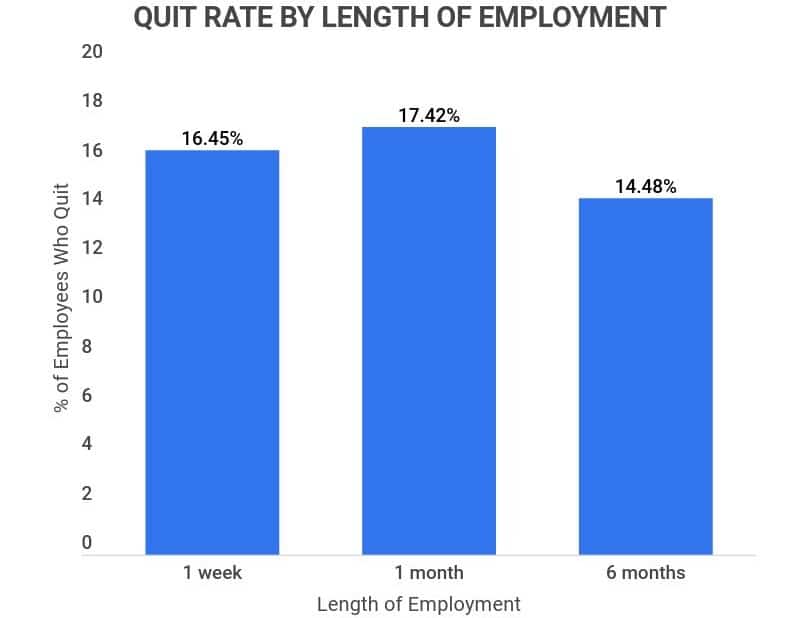Employee turnover is a burden to a small business. It’s often unexpected and takes time (and money) away from small business owners. In this article, we discuss employee turnover and how you can avoid it to ultimately get more hours back in your year and improve your bottom line.
What is employee turnover?
Employee turnover is the total number of employees who leave the organization over a given period (generally a year). Employee turnover includes both voluntary and involuntary turnover. Voluntary turnover includes people who quit and retire, whereas involuntary turnover includes people who are laid off or fired.
How is employee turnover calculated?
To calculate your employee turnover rate, divide the total number of employees that left the company by the total number of employees you started with. For example, if you started with 50 employees and 5 employees left in a given year, your turnover rate would be 5 divided by 50 (5/50) or 10%.
What is the cost of employee turnover?
Employee turnover costs add up quickly. They include the cost of advertising the position, the cost of the time of the manager and employees who have to screen and interview applicants, the cost of the time of the employees who have to train the replacement, and the cost of having the employee get up to speed. And this isn’t even everything.
Overall, it costs 33% of a worker’s annual salary to replace them if they leave, according to Employee Benefit News.

Why do employees leave?
Because employee turnover is so expensive and replacing employees is so time-consuming, it’s important to understand the reasons for turnover. Once you know why people leave, you can address the issue(s).
No work-life balance: With the rise of working remote, companies that require people to return to the office are seeing higher turnover rates because employees prefer and like their improved work-life balance, and don’t want to go back to the old ways.
Solution: Flexibility is the keyword for allowing more work-life balance amongst employees. Flexibility allows working parents to attend a PTA meeting or a distant employee to avoid a long commute. If you cannot offer this flexibility, the next best option is to plan their schedule as far in advance as possible to allow them ample time to schedule their life around their work schedule.
Boredom: People have the drive to grow, learn, and improve themselves, and a common reason for employee turnover is simply being bored with their current position.
Solution: Boredom can cause a workday to feel like a month. Talk about torture. On the other hand, flow is a state of mind in which a person becomes fully immersed in an activity, and time seems to fly by. People in flow are generally happier, more engaged, and more productive, among other benefits.
You can encourage flow states by providing clear goals, immediate feedback, and assignments that are slightly out of their comfort zone. Just be careful not to push them too far out of their comfort zone. Talk with them and agree on boundaries and trial periods.
A workplace survey report found that 94% of surveyed employees responded that if a company invested in helping them learn, they would stay longer.
Source: CareerPlug, 2021
Feeling overworked: Often, star employees are given more work because they are highly capable. Unfortunately, this can lead to burnout and eventually their decision to quit.
Solution: Carefully monitor employees for signs of burnout:
- Exhaustion
- Frequent illnesses
- Feelings of helplessness
- Self-doubt
- Loss of motivation
- An increasingly negative outlook
To counteract these symptoms, work with your employee to offer them assistance, such as helping them feel more in control, decreasing their workload, an employee assistance program, or even time off to regroup and recharge.
Lack of feedback: Feedback can be difficult to give and receive. However, employees do not know where they stand without it, and it’s easy for them to feel like they aren’t growing or improving. Lack of feedback is cited as another common reason for employee turnover.
Solution: Strive to give employees feedback often. The worst kind of feedback is no feedback. Even if negative feedback has to be given, it can help the employee improve and grow if done right. Also, remember that feedback doesn’t always have to come from the manager. Peer-to-peer feedback can be encouraged and built into the culture to help people continually grow and improve.

Lack of purpose: Many people associate their identity with what they do for work. If employees don’t feel passionate about what they’re doing or feel the work they do makes a difference, even on a small scale, they may be likely to find a workplace that fulfills that sense of purpose.
Solution: All work has a purpose, but sometimes employees lose sight of it. Leaders can help by sharing success stories and customer testimonials to remind employees how their work makes a difference. Positive feedback and specific thank you notes from managers can also help employees understand how they fit into the organization and how their work matters.
Poor fit: When people come to work but don’t feel like they get to use their unique gifts and talents in the workplace, they can start to feel disengaged and want to look for a job that better aligns with their skills and interests.
Solution: Make sure you understand your employees’ unique strengths, skills, and interests, and put those to work in your business. They will have more fun, be more engaged, and more productive, thus improving your bottom line.
Poor compensation: In a competitive market, if employees know they can get more money or other benefits they deem important in another organization, they are more likely to leave.
Solution: If you can afford to pay your employees more, it may be worth it to keep your star employees and avoid expensive turnover costs. But if you can’t, look into improving the other areas we discussed today.
Compensation is important, but if other critical needs are being met, employees may stay even if they know they could get paid more somewhere else.


